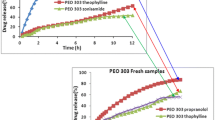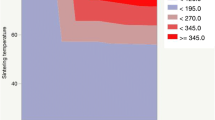Abstract
Polyethylene oxide has been researched extensively as an alternative polymer to hydroxypropyl methylcellulose (HPMC) in controlled drug delivery due to its desirable swelling properties and its availability in a number of different viscosity grades. Previous studies on HPMC have pointed out the importance of particle size on drug release, but as of yet, no studies have investigated the effect of particle size of polyethylene oxide (polyox) on drug release. The present study explored the relationship between polymer level and particle size to sustain the drug release. Tablets produced contained theophylline as their active ingredient and consisted of different polyethylene oxide particle size fractions (20–45, 45–90, 90–180 and 180–425 μm). It was shown that matrices containing smaller particle sizes of polyox produced harder tablets than when larger polyox particles were used. The release studies showed that matrices consisting of large polyox particles showed a faster release rate than matrices made from smaller particles. Molecular weight (MW) of the polymer was a key determining step in attaining sustained release, with the high MW of polyox resulting in a delayed release profile. The results showed that the effect of particle size on drug release was more detrimental when a low concentration of polyox was used. This indicates that care must be taken when low levels of polyox with different particle size fractions are used. More robust formulations could be obtained when the concentration of polyox is high. Differential scanning calorimetry (DSC) traces showed that particle size had no major effect on the thermal behaviour of polyox particles.






Similar content being viewed by others
REFERENCES
Colombo P, Bettini R, Massimo G, Catellani PL, Santi P, Peppas NA. Drug diffusion front movement is important in drug release control from swellable matrix tablets. J Pharm Sci. 1995;84:993–7.
Haan PD, Lerk CF. Oral controlled release dosage forms: a review. Pharm World Sci. 1984;6:57–67.
Kiss D, Suvegh K, Marek T, Devenyi L, Novak C, Zelko R. Tracking the physical aging of poly(ethylene oxide). AAPS PhamSci Tech. 2006;7:118–25.
Bailey FE, Koleske JV. Alkylene oxides and their polymer. New York: Marcel and Dekker; 1990.
Bailey FE, Koleske JV. Poly(ethylene oxide). New York: Academic; 1976.
Colombo P, Bettini R, Sant IP, Peppas NA. Swellable matrices for controlled drug delivery: gel-layer behaviour, mechanisms and optimal performance. Pharm Sci Technol Today. 2000;3:198–204.
Royce AE. Directly compressible polyethylene oxide vehicle for preparing therapeutic dosage forms. 1993; US Patent 5273758.
Kim CJ. Drug release from compressed hydrophilic Polyox® WSR tablets. J Pharm Sci. 1993;84:303–6.
Chatani Y, Okamura S. Crystal structure of poly(ethylene oxide)–sodium iodide complex. Polymer. 1987;28:1815–20.
Rowe RC, Sheskey PJ, Weller PJ. Handbook of pharmaceutical excipients. 4th ed. London: Pharmaceutical Press; 2003.
Dimitrov M, Lambov N. Study of Verapamil hydrochloride release from compressed hydrophilic Polyox-Wsr tablets. Int J Pharm. 1999;189:105–11.
Zhang F, McGinity JW. Properties of sustained-release tablets prepared by hot-melt extrusion. Pharm Dev Technol. 1999;4:241–25.
Dhawan S, Sinha VR. Applications of poly(ethylene oxide) in drug delivery systems part II. Pharm Technol. 2005;9:82–96.
Mitchell K, Ford JL, Armstrong DJ, Elliott PNC, Hogan JE, Rostron C. The influence of the particle size of hydroxypropylmethylcellulose K15M on its hydration and performance in matrix tablets. Int J Pharm. 1993;100:175–9.
Liew CV, Chan LW, Ching AL, Heng PSW. Evaluation of sodium alginate as drug release modifier in matrix tablets. Int J Pharm. 2006;309:25–37.
Nokhodchi A, Rubenstein MH, Ford JH. The effect of particle size and viscosity grade on the compaction properties of hydroxypropylmethylcellulose 2208. Int J Pharm. 1995;126:189–97.
Landín M, Rowe RC, York P. Particle size effects on the dehydration of dicalcium phosphate dihydrate powders. Int J Pharm. 1994;104:271–5.
Akbari J, Nokhodchi A, Farid J, Adarangui M, Siahi–Shahdad MR, Saeedi M. Development and evaluation of buccoadhesive propranolol hydrochloride tablet formulations: effect of fillers. IL- Farmaco. 2003;59:155–61.
Boyapally H, Nukala RK, Bhujbal P, Douroumis D. Controlled release from directly compressible theophylline buccal tablets. Colloids Surf B: Biointerfaces. 2010;77:227–33.
Sabnis S, Adeyeye SM. Controlled-release hydrophilic tablets for individualized theophylline therapy. Drug Dev Ind Pharm. 1998;25:187–96.
Kaialy W, Martin GP, Ticehurst MD, Royall P, Mohammad MA, Murphy J, et al. Characterisation and deposition studies of recrystallised lactose from binary mixtures of ethanol/butanol for improved drug delivery from dry powder inhalers. AAPS J. 2011;13:30–43.
USP Pharmacopoeia 26 National Formulary 21, USP Convention, Rockville, 2003.
Khan KA. Concept of dissolution efficiency. J Pharm Sci. 1975;271:48–9.
Moore JW, Flanner HH. Mathematical comparison of dissolution profiles. Pharm Tech. 1996;20:64–74.
Al-Khattawi A, Iyire A, Dennison T, Dahmash E, Bailey CJ, Smith J, et al. Systematic screening of compressed ODT excipients: cellulosic versus non-cellulosic. Curr Drug Deliv. 2014;11(4):486–500.
Chattoraj S, Shia L, Sun CC. Understanding the relationship between crystal structure, plasticity and compaction behaviour of theophylline, methyl gallate, and their 1:1 co-crystal. Cryst Eng Comm. 2010;12:2466–72.
Cahyadi C, Chan LW, Colombo P, Heng PWS. The butterfly effect: a physical phenomenon of hypromellose matrices during dissolution and the factors affecting its occurrence. Int J Pharm. 2011;406:31–40.
Aldrete ME, Villafuerte-Robles L. Influence of the viscosity grade and the particle size of HPMC on metronidazole release from matrix tablets. Eur J Pharm Biopharm. 1997;43:173–8.
Heng PWS, Chan LW, Easterbrook MG, Li XM. Investigation of the influence of mean HPMC particle size and number of polymer particles on the release of aspirin from swellable hydrophilic matrix tablets. J Control Rel. 2001;76:39–49.
Wu N, Wang LS, Tan DC, Moochhala SM, Yang YY. Mathematical modelling and in vitro study of controlled drug release via a highly swellable and dissoluble polymer matrix: polyethylene oxide with high molecular weights. J Control Rel. 2005;102:569–81.
Apicella A, Cappello B, Del Nobile MA, La Rotonda MI, Mensitieri G, Nicolais L. Poly(ethylene oxide) (PEO) and different molecular weight PEO blends monolithic devices for drug release. Biomaterials. 1993;14:83–90.
Di Colo G, Burgalassi S, Chetoni P, Fiaschi MP, Zambito Y, Saettone MF. Relevance of polymer molecular weight to the in vitro/in vivo performances of ocular inserts based on poly(ethylene oxide). Int J Pharm. 2001;220:169–77.
Wan LSC, Heng PWS, Wong LF. Relationship between swelling and drug release in a hydrophilic matrix. Drug Dev Ind Pharm. 1993;19:1201–121.
Hiremath PS, Saha RN. Controlled release hydrophilic matrix tablet formulations of isoniazid: design and in vitro studies. AAPS PharmSciTech. 2008;9:1171–8.
Maggi L, Segale L, Torre ML, Ochoa ME, Conte U. Dissolution behaviour of hydrophilic matrix tablets containing two different polyethylene oxides (PEOs) for the controlled release of a water-soluble drug. Dimensionality study. Biomaterials. 2002;23:1113–9.
Lotfipour F, Nokhodchi A, Saeedi M, Norouzi-Sani S, Sharbafi J, Siahi-Shadbad MR. The effect of hydrophilic and lipophilic polymers and fillers on the release rate of atenolol from HPMC matrices. IL Farmaco. 2004;59:819–25.
Alderman DA. A review of cellulose ethers in hydrophilic matrixes for oral controlled-release dosage forms. Int J Pharm Tech Prod Mfr. 1984;5:1–9.
Ford JL, Rubinstein MH, Hogan JE. Formulation of sustained-release promethazine hydrochloride tablets using hydroxypropyl methyl cellulose matrixes. Int J Pharm. 1985;24:327–38.
Asare-Addo K, Levina M, Rajabi-Siahboomi AR, Nokhodchi A. Effect of ionic strength and pH of dissolution media on theophylline release from hypromellose matrix tablets—Apparatus USP III, simulated fasted and fed conditions. Carbohydr Polym. 2011;86:85–93.
Asare-Addo K, Levina M, Rajabi-Siahboomi AR, Nokhodchi A. Study of dissolution hydrodynamic conditions versus drug release from hypromellose matrices: the influence of agitation sequence. Colloids Surf B: Biointerfaces. 2010;81:452–60.
Asare-Addo K, Conway BR, Larhrib H, Levina M, Rajabi-Siahboomi AR, Tetteh J, et al. The effect of pH and ionic strength of dissolution media on in-vitro release of two model drugs of different solubilities from HPMC matrices. Colloids Surf B: Biointerfaces. 2013;111:384–91.
Velasco MV, Ford JL, Rowe P, Rajabi-Siahboomi AR. Influence of drug: hydroxypropylmethylcellulose ratio, drug and polymer particle size and compression force on the release of diclofenac sodium from HPMC tablets. J Control Rel. 1999;57:75–85.
Reynosa VCS, Yukimitu K, Nagami T, Carvalho CL, Moraes JCS, Araujo EB. Crystallization kinetics in phosphate sodium-based glass studied by DSC technique. J Physics Chem Solids. 2003;64:27–30.
Korsmeyer RW, Gurny R, Deolker E, Buri P, Peppas NA. Mechanisms of solute release from porous hydrophilic polymers. Int J Pharm. 1983;15:25–35.
Heng PWS, Chan LW, Easterbrook MG, Li X. Investigation of the influence of mean HPMC particle size and number of polymer particles on the release of aspirin from swellable hydrophilic matrix tablets. J Controlled Release. 2001;76:39–49.
Author information
Authors and Affiliations
Corresponding author
Rights and permissions
About this article
Cite this article
Shojaee, S., Emami, P., Mahmood, A. et al. An Investigation on the Effect of Polyethylene Oxide Concentration and Particle Size in Modulating Theophylline Release from Tablet Matrices. AAPS PharmSciTech 16, 1281–1289 (2015). https://doi.org/10.1208/s12249-015-0295-z
Received:
Accepted:
Published:
Issue Date:
DOI: https://doi.org/10.1208/s12249-015-0295-z




